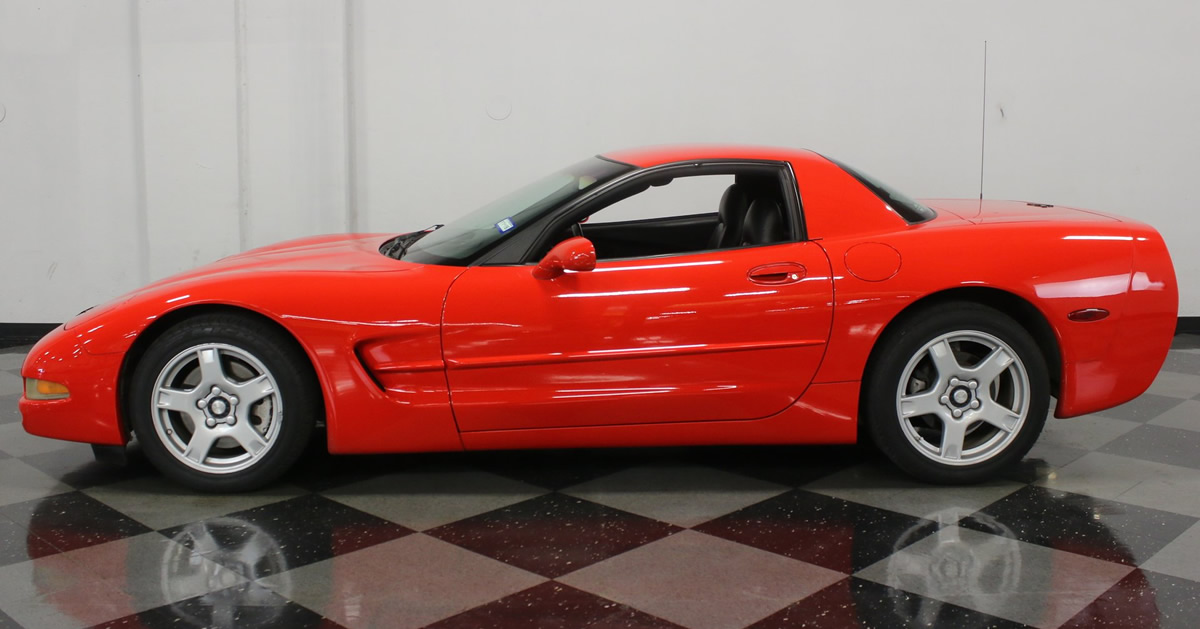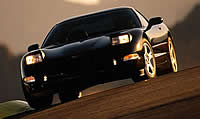The 1999 Corvette Hardtop: A Billy-Bob? Not! - Page 1 of 2
© by Hib Halverson
No use without permission, All Rights Reserved
The introduction of the fifth-generation, Chevrolet Corvette began with a splash in November of 1996 at the National Corvette Museum in Bowling Green, Kentucky. After a briefing in the Chevrolet Theater by Chief Engineer, Dave Hill, members of the automotive press walked out of the NCM to find a dozen or so '97 Corvette Coupes. The suspense was over.
C5 had arrived.
In May of 1998, the 18-month C5 media intro ended with a shock inside a parking structure at Indianapolis, Indiana. In this industrial setting, lit by naked, orangeish lights, we found Dave Hill surrounded by a trio of his cars. A large ventilation fan twirled in the background. His voice echoed amongst the concrete columns and competed with the drone of some unseen air conditioning plant as he introduced the final C5: the 1999 Hardtop.
The Corvette for hardcores.
It was the final piece of the puzzle: a car for which the lunatic fringe of the Corvette hobby had waited 18 long months. Forget such gadgetry as: power passenger seats, memory options, two tops, F45 shocks and dual-zone HVAC. With the Hardtop, you get basic, kick-ass performance from the 345hp LS1 Gen3 V8, a six-speed stick-shift and Z51 suspension all in a car that weighs 80 pounds less and is stiffer than the already stout Coupe.
The shock was the Hardtop coming in as such an aggressive offering.
Previous to the car's debut, rumors ran rampant in the Corvette community the car would be a decontented, price leader. The genesis of this belief was, perhaps, remarks former Chevrolet General Manager Jim Perkins made in the '94-'95 period that nicknamed "Billy-Bob" what was officially known back then as the "FRC" or Fixed-Roof Coupe. Perkins, a Texas good old boy, was alluding to the hardtop originally being aimed at the thrifty, Billy-Bobs of the world wanting a Corvette at a lower price.
Initially, the coming-Hardtop (some jokesters labeled it "William-Robert") was vilified by Corvette "libertarians" who demanded an aggressive, no-frills "race" car. In early April, 1998 the situation seemed to get more grim. Chevy was uncharacteristically loose with information. The preliminary 1999 Dealer Order Guide was sent to out early that month and many dealers promptly passed-out copies of the Corvette section to anyone that asked. It confirmed our worst fears. The hardtop would be just a mild-mannered Billy-Bob. It was decontented from the Coupe, had a minimal option list, came with automatic trans and base suspension only, along with cheaper tires and a speed limited engine. The guide also listed an option, RPO Z19. When ordered, it restored much of the Coupe's performance pieces. Three weeks later, Chevy notified dealers that Z19 was canceled. I was crushed and a little embarrassed because, a week before, I sent an article to Vette Magazine for the August issue to press with the Z19 story.
Imagine our surprise when we got to Indianapolis at the end of May to find the Hardtop was the most aggressive C5 yet. We were further astonished to hear all '99 hardtops would be that way. There would be no Billy-Bob.
Price Leader or Race Leader
An interesting aspect of covering the Corvette is the controversy and intrigue the car creates inside the company that makes it. General Motors Corporation is pretty staid and conservative--no secret there, huh. Thankfully, deep, deep inside GM's often boring but practical persona is a g-spot called Corvette. It's a brash, in-your-face product amongst the sedans, SUVs and minivans embraced by the ignorant, blissful masses.
This near-half-century-old icon is GM's highest performing product as well as one of the few image cars it builds these days. Corvette attracts the most passionate of engineers, designers and managers to the team responsible for producing it at GM's Midsize/Luxury Car (MidLux) Group. Obviously, amongst these zealots who guard the fire of America's Sports Car there are strong opinions of what a Corvette should be.
There is another, different group that also controls Corvette's destiny, composed of people at Chevrolet who market the car, do its public relations, research the needs of its customers, process the statistics, communicate those needs to MidLux, sell the car and design its advertising. Many of those folks believe just as strongly in the Corvette mystique as the hardware types over at MidLux.
It doesn't take a rocket scientist to figure these two groups, the passionate engineers and the equally-devoted sales and marketing specialists are going to clash and occasionally the fight ain't gonna be pretty. Sometimes this is counterproductive. Other times, while the stress level might rise temporarily, the result is a better Corvette.
Conflict arose over Hardtop's production configuration and it went right down to the wire. The development team and the Brand Team were in dispute over whether the hardtop would be a decontented, entry-level "waxer" or hardcore, haul-ass, racer. The Brand Team, led by Brand Manager, Dick Almond, wanted a moderately decontented, price-leader with some performance options. The MidLuxers, lead by Chief Engineer, Dave Hill, wanted a pure, performance sports car.
The two sides skirmished into early May. At one point the Brand folks must have felt confident that the wind was blowing their way because Chevrolet issued the preliminary Dealer Order Guide with the information we published back in the August issue, but when the smoke cleared in mid-May; MidLux seemed to have won the war. Dave Hill is acknowledged by sources inside GM and some outside observers as being a skillful politician. We've even heard the word "aggressive" used in that context. We know Hill, who is, in addition to Chief Engineer, the GM Vehicle Line Executive for Performance Cars, believes very strongly in his idea of what a Corvette should be and is usually quite determined in his promotion of those those beliefs inside the corporation. It appears that his strategy in the Hardtop debate was, for the most part, successful.
At the end of the month, media showed up at Indy to find mild-mannered William-Robert had undergone last-minute, corrective surgery. Hardtops were steak-and-potatoes all the way with the unrestricted LS1, a six-speed, Z51 suspension, big tires and wheels and minimal options.
At the Hardtop preview, Chevrolet announced Dick Almond was taking a promotion out of the Brand Team, back into its field sales staff in a high-level executive position. We asked Almond if his sudden move was influenced by the struggle between the two groups. He denied that, telling Vette, "...differences of opinion and frank exchange of views are always a part of any matrix management system." He went on to say that he had been anxious to "return to his roots" in the field sales side of the business and that the timing of the move was coincidence more than anything else. Almond will go down in history as the first Corvette Brand Manager and as presiding over one of the more successful new car launches in Chevrolet history. He has done a number of good things for Corvette in his four years in the job and we are sorry to see him go.
Once the "differing of opinion and frank exchanging of views" were complete, the two sides pulled back, accepted the outcome and assessed their casualties. Was it a nasty battle? Perhaps. In the end, we think the Corvette enthusiast ended up with a better car. The decontented-price-leader idea has not been deep-sixed. It's timing was just not right. Dick Almond told Vette the idea was "...put on the shelf." Our guess is, after a couple of years, if Corvette sales slow a bit; we just might see a thrifty, Billy-Bob on dealer sales floors, but for now; we get the hardcore Hardtop.
 |
A Bit on the Techside
The Hardtop's underbody structure is the stiffiest of all C5s. It has both the Coupe's "top bow" and the extra crossbar behind the seats, characteristic of the Convertible. Its exterior bodywork behind the windshield and above the belt line is bolted to the windshield header and is bolted and adhesively bonded to the rear deck. The underbody structure, the hard top and the lack of the big hole in the back for the hatch make the Hardtop about 12% stiffer in torsion and bending than the Coupe with its roof in place. Additionally, though the removal of the coupe's heavy hatch glass and lighter top structure, the Hardtop's curb weight is 92 pounds less than the lightest Coupe.
All the Hardtops come with the Tremec T56 six-speed transmission, a 3.42 limited slip axle and the Z51 Performance Handling Package which consists of higher rate springs and stabilizer bars and a set of stiffer, fixed-valve, shocks. The only performance option is the RPO JL4 Active Handling System. "AH" piggybacks to ABS and traction control and can assist the driver in maintaining control in gross oversteer/understeer situations with momentary brake intervention on a single wheel basis. Vette tested the system in the March issue and we feel Active Handling can make 95 percent of Corvette drivers faster and safer in most performance driving or accident avoidance situations.
The rest of the Hardtop's option list is limited to two items, a power driver seat and sound systems. Other stuff like the Memory feature, Head-Up Display, Telescoping steering column, Dual-Zone HVAC and sport seats are left to well-heeled gadgeteers.
Before we get to a short test of the Hardtop, there are some new features of the 1999 Corvette Coupe and Convertible to discuss. "Twilight Sentinel" is the name GM applies to devices that sense low-light driving conditions and turn on the car's headlights. To date, Corvette has been a car with its "comfort/control" compromise skewed strongly towards control, so we are not sure a lot of customers are going to want another option that does their work for them and (of course) pushes up the car's cost. Nevertheless, dealers will love the Twilight Sentinel—another option they can hang on stock units. C5ers, if they choose the Twilight Sentinel, can now simply stop thinking about headlights.
Another new option on Coupes and Convertibles is an electric, telescoping steering column which, in our opinion, is more useful than a Twilight Sentinel. While a tilt wheel was available through the C4 era, a telescoping wheel was dropped in 1990 when the Feds forced airbags on us. Because C5 fits a wider range of driver "sizes" the telescoping wheel has returned, but this time it is electric. The combination of the tilt and telescope features allows more drivers to find the perfect steering wheel location.
Lastly, we have the Head-Up Display (HUD), clearly the most technically innovative new feature for next year. A Corvette HUD has been under development since the early C4 era. In 1985, in a move to gain technology transfer, GM bought Hughes Aircraft, a major defense contractor. One of the assignments Hughes got was adapting military aircraft HUD technology to GM's automotive products.



